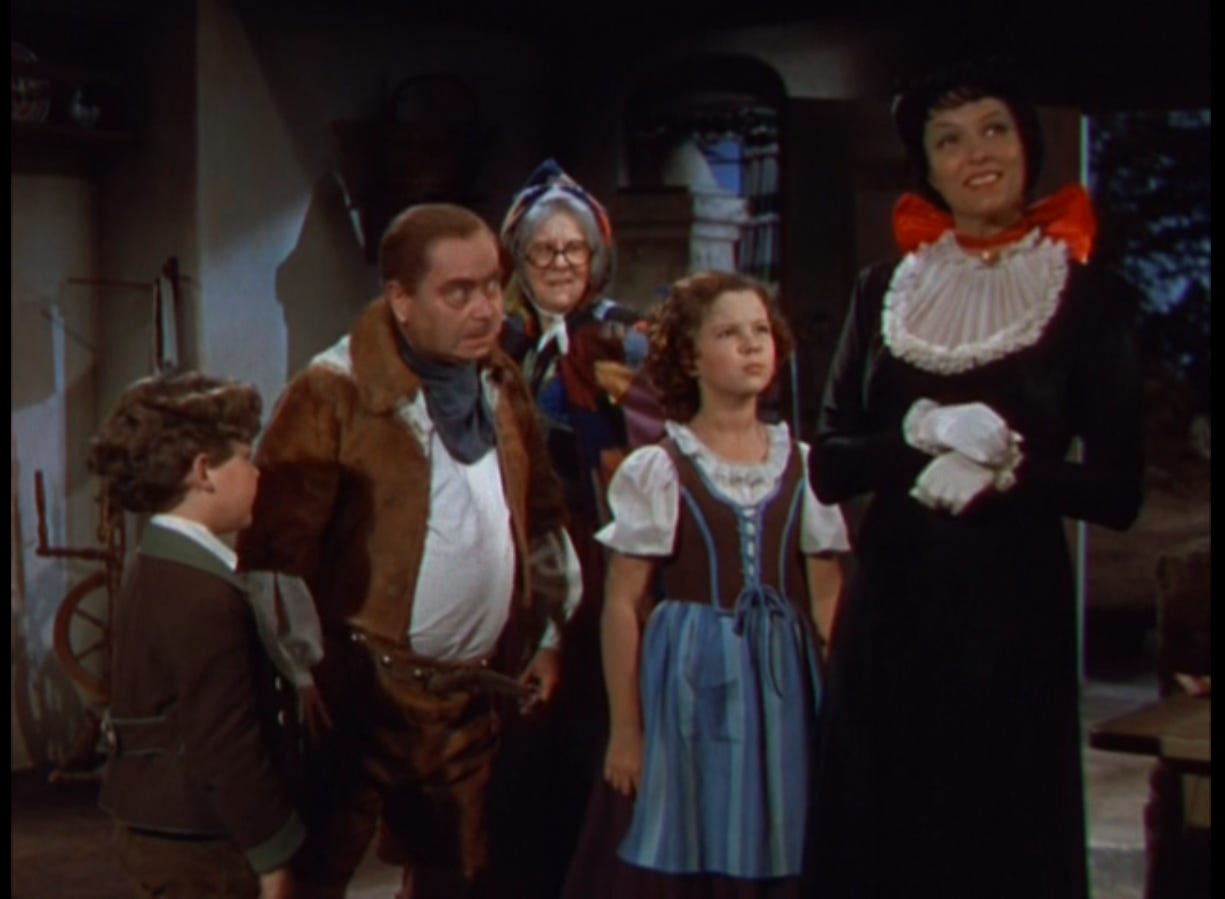The Blue Bird (1940)
The Blue Bird is kind of infamous among film buffs and Shirley Temple fans. If anyone’s not familiar with the movie and its surrounding story, well, have fun.
It opens in black and white. The setting is a forest, where Mytyl and her little brother Tytyl are busy trapping a rare bird in a cage. Mytyl is kind of a selfish brat who knows she’s a brat but who doesn’t care enough to really change her behavior. She’s got a reputation around the village for her selfishness.
After a sulky dinner at home, Mytyl goes to sleep and wakes up to find everything in purty Technicolor and the Fairy Berylune at her door, hurrying she and Tytyl on a journey to find the Blue Bird of Happiness. They’ve got Light to guide them, and Tylo the dog and Tylette the cat transformed into human form to fill out the party.
The kids try looking in the Land of the Past, where they meet their deceased grandparents, and the Land of Luxury, where all they get is spoiled. Then it’s off to the forest, where a fire starts and Tylette gets her just desserts (She’s not the nicest cat person anyway). The journey winds up in the Land of the Future, where toga-clad children wait to be born.
No matter what they do, the kids can’t find the Blue Bird, at least not while they’re looking for it. It’s not a huge spoiler to say that the bird is where they least expect it…at home. Right in their own backyard.
So. Yeah. Anything look familiar about this movie? Like, really, really familiar?
As in, somewhere over the rainbow kind of familiar?
While The Blue Bird is loosely based on a 1908 play by Russian playwright Maurice Maeterlinck (and it’s not the first or the last time The Blue Bird has been adapted for the screen), it’s a pretty blatant ripoff of 1939’s The Wizard of Oz. It goes from black and white to color, it has characters from the real world appearing in the fantasy world, there’s a beautiful woman sorta guiding the proceedings, and the characters follow this nebulous unnamed path. No, the path isn’t made of yellow brick, although it might as well be. No, Mytyl doesn’t have magic shoes, but I kept expecting her to. Like Dorothy, though, she has to make a long journey through a strange land to find contentment at home.
Oh, and we can’t forget the most vigorous nod of all: The original Wicked Witch of the West, Gale Sondergaard, plays the de facto villain of the piece, Tylette. The only difference is that she burns instead of melts.
The Oz angle aside, The Blue Bird is endlessly mediocre and impersonal. There’s no sense of wonder. The film isn’t clever in the slightest. Bird recycles the page-turning opening credits from Heidi except with different actors. It has no transitions; the film abruptly cuts between settings and we don’t see the characters earning anything, so it’s tough to feel any sympathy for them. Whatever happens is all just kinda there.
1940 audiences gave the film a hard pass, and by mutual agreement Shirley Temple ended her contract with Twentieth Century Fox. Everyone knew it was only a matter of time; Temple was twelve in 1940 and growing up fast, so her days of playing a moppet were over. Her last movie for Fox was Young People, a wan Babes In Arms ripoff that featured clips from Temple’s previous films. Her next movie, Kathleen was another yawn and her only film made at MGM.
Would The Blue Bird have been more of a success if the filmmakers hadn’t tried so hard to mooch off of Oz? Nah. The original Maeterlinck play is off-puttingly strange and not Production Code-friendly. In the end, though, what could have been is neither here nor there. The Blue Bird is only watchable for the Oz hacks and not much else.
The Blue Bird is currently streaming on Tubi. Not rated.
My grade: C-
Principal cast: Shirley Temple, Spring Byington, Nigel Bruce, Gale Sondergaard, Eddie Collins, Sybil Jason, Jessie Ralph, Helen Ericson, Johnny Russell, Laura Hope Crews, Russell Hicks, Gene Reynolds, Al Shean, Cecilia Loftus, Leona Roberts
Directed by Walter Lang
Written by Maurice Maeterlinck (play), Ernest Pascal and Walter Bullock
For further reading: Shirley Temple: American Princess, written by Anne Evans. Lyons Press, 2017.




